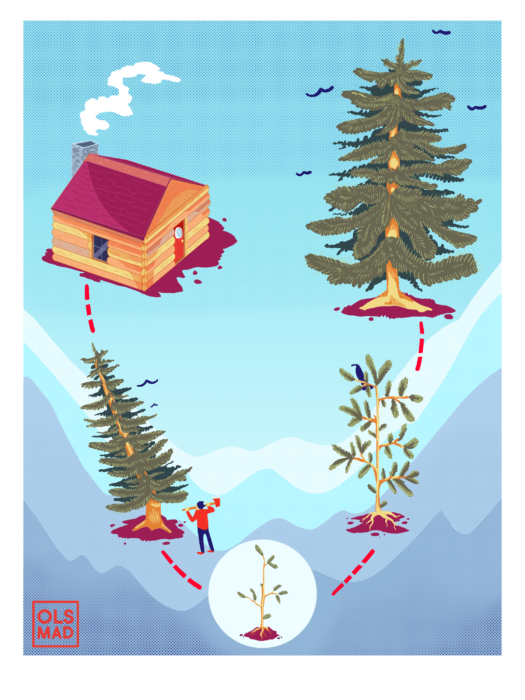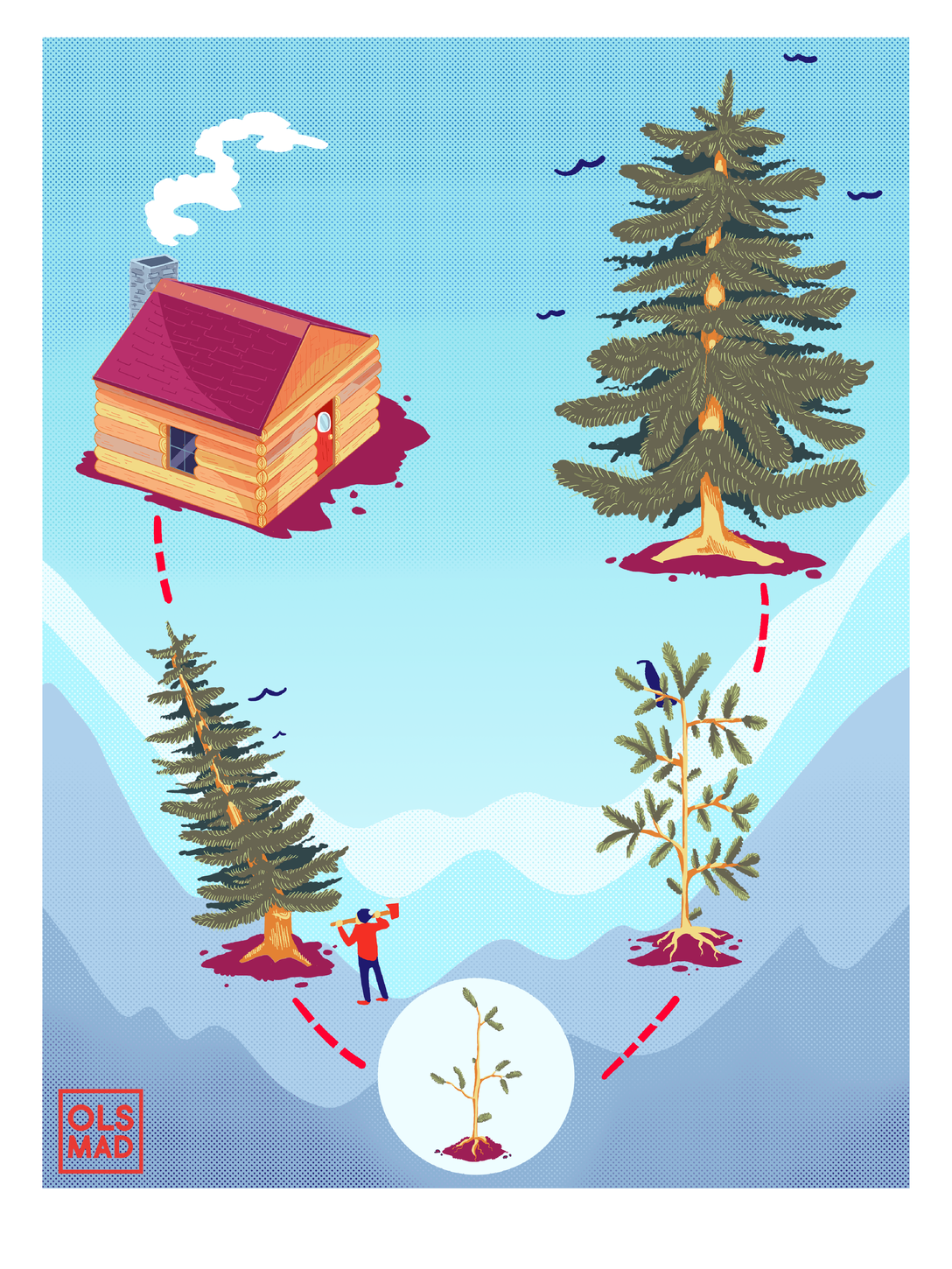
Along the northern reaches of the chilly Pacific Ocean, stands of Douglas fir, western red cedar, spruce, and hemlock tower 100 feet or more in the air. Their upper boughs are often shrouded in mist, and knobby roots keep hold of thick, peaty forest soil. They shelter black bears, Roosevelt elk, spotted owls, marbled murrelets, and mountain lions, just to name a few.
They are also among the planet’s best carbon sinks. Scientists say these forests can sequester more carbon per acre than even the rain forests of the Amazon, and keep it locked up for 800 years. “We live in a carbon-dense forestry region, and we should be managing for carbon as one of the outcomes,” said Brad Kahn, director of communications for the Forest Stewardship Council, a nonprofit that certifies sustainably-grown wood.
Exactly how that should take place, though, has sparked heated debate in this lush corner of the West. Some in the timber industry believe the best way is to turn forests into lumber, and replant with young stands thirsty for carbon dioxide. But some conservation groups are pushing back, saying the better way to keep carbon locked up in forests is to let them grow and grow.
The nation’s most carbon-dense national forests are in the Northwest, according to the GEOS Institute, an Ashland, Oregon, nonprofit that works on climate change solutions. They are the Tongass in Alaska; Okanogan-Wenatchee and Mount Baker-Snoqualmie in Washington; and the Willamette and Rogue River-Siskiyou national forests in Oregon.
A growing body of research suggests preserving these forests may be needed to stem the worst effects of climate change. Keeping Northwest and Northern Rockies forests pristine would sequester the same amount of carbon dioxide that is released in eight years of fossil fuel burning in the lower 48 states, according to a recent estimate by scientists from Oregon State University.
“Carbon in the forest is carbon that is not in the atmosphere,” said Beverly Law, the director of Oregon State’s Terrestrial Ecosystem Research and Regional Analysis group. “I think people finally get it when you say it that way.”
Like all plants, trees inhale carbon dioxide and exhale oxygen. As they grow, they store carbon in leaves, trunks, and roots. Typically, a live tree is one-half carbon by weight. Much of that carbon remains in the tree when it is harvested, but some is released back into the atmosphere when waste is burned or decomposes. Some is emitted during the milling process for lumber, and logging itself is a source of greenhouse gas emissions, since equipment runs on fossil fuels.
The view of many environmental groups is that a mature, unlogged forest holds carbon like a bucket, and harvesting timber springs a leak. Selective cutting keeps the bucket from leaking as quickly, while intensive, frequent logging causes carbon to seep out even faster. “There’s a growing consensus in the environmental community that if we’re serious about leveraging forests as a solution to climate change, we need climate-friendlier forestry,” said Jason Grant, chair of the Sierra Club’s forests and climate team.
The timber industry’s view: a rotating harvest of young, healthy stands is the best bet. A stand of Douglas fir, the prominent lumber product in the Northwest, sequesters carbon fastest when it’s between 30 and 70 years old, according to research from the U.S. Forest Service, and its capacity for the element maxes out after about 100 years. That’s because an old forest is a decaying forest, said Cindy Mitchell, senior director of public affairs for the Washington Forest Protection Association, an industry group. Beyond that 100-year threshold, it “becomes a liability, from a carbon perspective.”
Mitchell notes that about 101,000 jobs in Washington alone are supported by the industry’s cycle of continuous growth and harvest, and only about 2 percent of Washington’s actively-managed forest land is harvested each year.
Plenty of researchers disagree with Mitchell, though, and there’s a wide range of estimates for when carbon sequestration slows down as a forest ages. William Moomaw, a professor emeritus at Tufts University and lead author on five reports of the Intergovernmental Panel on Climate Change, has said preserving existing mature forests does more to slow global warming than planting young trees. Old forests are better at sequestering carbon — not just in their trunks, but in the soil, as well. Plus, they are more diverse biologically, help control flooding, and can be more resilient to forest fires.
Carbon harvested in the form of timber can also find its way back to the atmosphere. Law and her team of OSU researchers calculated that the timber harvested from West Coast forests since 1900 contained the equivalent of 10.7 billion metric tons of carbon dioxide, and 81 percent of it has either been returned to the atmosphere or dumped in landfills.
Is there a middle ground that would keep more carbon in the forest without having a major financial impact on the industry? David Diaz thinks there is. The director of forestry technology and analytics with Ecotrust, a Portland-based nonprofit promoting sustainable resource economies, Diaz said extending harvest rotations — growing trees for five or 10 additional years — could lock up more carbon without having a significant financial impact, especially if landowners were given incentive payments for waiting. Northwest timber is typically harvested when trees are 35 to 40 years old.
Ecotrust tests these methods out with a subsidiary that manages more than 100,000 acres of working forest. Diaz doesn’t think extending the harvest is likely to happen in big, corporate-owned stands — those companies have a duty to stockholders to maximize profits — but longer rotations could be put to use by tribes, small landowners, and in state and federal forests, he said. Law, at Oregon State, has suggested doubling the length of the harvest cycle to 80 years in the temperate coastal range, where the risk of forest fires is lower.
The industry says all of these proposals would deal an economic blow. Even extending the harvest by five or 10 years could result in lost jobs, Mitchell said; at minimum, it’s five or 10 years of diminished revenue. Diaz thinks a doubling of the harvest rotation is unrealistic, and both he and Mitchell believe there’s a danger with overly restrictive logging plans: If there’s a shortage of American lumber, builders might buy from places where the forests receive less protection.
While the debate plays out among scientists, leaders in D.C. are pressing for more logging. The Trump administration called for a dramatic increase in timber leases, saying logging helps curb wildfires — a position many researchers disagree with. The administration is also proposing new rules that could open Alaska’s Tongass National Forest, one of the most carbon-rich in the nation, to greater timber harvest.
That concerns John Talberth, president and senior economist at Portland’s Center for Sustainable Economy. From 2000 to 2018, the U.S. lost 94 million acres of tree cover — not just for wood and paper products, but also to clear the land for agriculture, urban development and infrastructure. That logging, according to Global Forest Watch, has expelled more than 10.6 gigatons of carbon dioxide.
“The absolute priority is to stop the hemorrhaging of carbon dioxide into the atmosphere,” Talberth said. Protecting the Northwest’s carbon-rich coastal forests could be a down payment on that work.
This story had been edited to correct the acreage of working forest Ecotrust manages.

